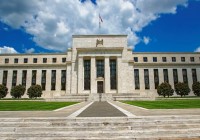This week, the crypto market was once again shrouded by macroeconomic clouds. The synchronized decline of Bitcoin and Ethereum appears to be a direct response to the weakness in US stocks and geopolitical tensions, but behind this lies a profound game about the pricing logic of risk assets. As all eyes are focused on the upcoming speech by Federal Reserve Chairman Powell, we should not only see price fluctuations but also gain insight into the role transformation of crypto assets in the current global macroeconomic chessboard.
The Unified Heartbeat of "Risk Assets": When Bitcoin Becomes the Shadow of Nasdaq
Today's early morning market trend once again confirms a trend that has become increasingly clear in recent years: in the face of macroeconomic uncertainty, cryptocurrencies, especially Bitcoin, have a heartbeat almost completely synchronized with tech stocks like Nasdaq. The Nasdaq index's decline reflects the market's widespread sentiment of avoiding high-growth, high-risk assets.
The core of this avoidance sentiment stems from the fear of future "cost of money" - that is, interest rates. The originally anticipated "50 basis point rate cut" is now a distant dream, and the current focus is whether Fed Chairman Powell will completely extinguish the market's last glimmer of hope for loose policy with hawkish rhetoric. In this context, any slight movement, whether the resurgence of the Russia-Ukraine conflict or economic data below expectations, will be interpreted by the market as one less reason to hold risk assets.
Therefore, simply attributing Bitcoin's decline to "negative news" is insufficient. A more accurate description is that Bitcoin is being forced to reposition its role by the global capital market - it is not digital gold, at least not now, but an alternative to high-beta tech stocks. Its rise and fall reflect the tides of global liquidity, rather than its intrinsic value storage narrative.
Beneath the Iceberg: Insights Revealed by Data
Price is the surface of market sentiment, while on-chain data allows us to glimpse the iceberg beneath the water. In our preliminary analysis, we discovered some noteworthy phenomena:
- Exchange Flows Remain Stable: Despite the price decline, no massive panic selling has occurred. Data shows that the inflow of Bitcoin and Ethereum to exchanges in the past 24 hours did not show extreme peaks. This indicates that many long-term holders (Hodlers) chose to "stay put", and the current selling pressure comes more from short-term traders and some leveraged positions.
- Derivatives Market Cooling: As prices fell, we observed that perpetual contract funding rates tend towards negative values. This suggests that market sentiment to short has risen, with traders establishing positions for further decline. However, whale-level liquidation events are not prominent, suggesting that the market's leverage level is relatively healthy with low systemic risk.
- Stablecoins Show Net Outflow: A more worrying signal is the slight decrease in stablecoin reserves on exchanges. This might mean that some funds have chosen to temporarily exit and wait, rather than buy the dips. This aligns with the "bated breath" state of waiting for Powell's speech.
Overall, on-chain data paints a picture of "cautious, not panicked". The market is actively deleveraging, preparing for the upcoming macroeconomic "judgment".
Ethereum's "Dual Narrative" Dilemma
In this decline, Ethereum's drop was slightly larger than Bitcoin's, reflecting its "dual narrative" dilemma.
On one hand, as the second-largest crypto asset, Ethereum cannot escape the gravitational pull of the macroeconomic environment and must bear the pressure of risk assets being repriced along with Bitcoin.
On the other hand, Ethereum's own ecosystem narrative is also being tested. During optimistic market sentiment, Layer2's activity, DeFi protocol innovations, and restaking track could be catalysts for independent growth. However, when macroeconomic clouds loom, these internal positives often seem pale and powerless. Investors will temporarily ignore these complex intrinsic values and choose to trade with the simplest logic - "it's also a risk asset".
It can be said that Ethereum is temporarily suppressed by the macro "strong narrative" over its internal "micro narrative". Its resilience depends not only on the macroeconomic environment warming up but also on whether its ecosystem can demonstrate sufficient resilience and innovative capacity in the bear market to convince capital to stay.
Conclusion: Calm Before the Storm, How to Find Direction?
In summary, the current market decline is not an isolated event but a scene in the global macroeconomic drama. Everyone's eyes are on the Federal Reserve, waiting for the "oracle" that will set the tone for global asset prices.
For investors and observers, what needs attention now is not just the red and green alternation on the K-line chart, but also the following key indicators:
- Powell's Speech Tone: Dovish or hawkish? Any wording about inflation, employment, and future interest rate paths will directly determine the market's short-term direction.
- US Dollar Index (DXY): As the "seesaw" of global risk assets, a strong dollar will continue to put pressure on the crypto market.
- Bitcoin's Key Technical Support: Whether the price can stabilize near important long-term moving averages (such as the 200-day moving average) will be crucial in determining the market's medium-term bottom.
In the macroeconomic turbulent waves, the crypto market ship is seeking a new course. Before the storm arrives, maintaining insight into fundamentals and understanding macroeconomic logic is more important than ever.






